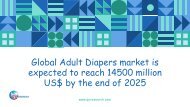Global Pediatric Hearing Aids Market Research Report Overview
Pediatric hearing aids are designed for children. These devices amplify the sound for the wearer with the aim of making a speech more intelligible and to correct impaired hearing as measured by audiometry. https://www.qyresearch.com/index/detail/178182/global-pediatric-hearing-aids-market
Pediatric hearing aids are designed for children. These devices amplify the sound for the wearer with the aim of making a speech more intelligible and to correct impaired hearing as measured by audiometry.
https://www.qyresearch.com/index/detail/178182/global-pediatric-hearing-aids-market
Create successful ePaper yourself
Turn your PDF publications into a flip-book with our unique Google optimized e-Paper software.
<strong>Global</strong> <strong>Pediatric</strong> <strong>Hearing</strong> <strong>Aids</strong><br />
<strong>Market</strong> <strong>Research</strong><br />
Report Overview<br />
QYRESEARCH FOCUS ON MARKET SURVEY AND RESEARCH<br />
www.qyresearch.com
Beijing Hengzhou Bozhi International<br />
Information Consulting<br />
Web: qyresearchglobal.com | qyresearch.com<br />
TEL:+86-13660489419, Office:+86-2086655165<br />
Media: press@qyresearch.com<br />
<strong>Market</strong>ing: sales@qyresearch.com<br />
Facebook: @QY<strong>Research</strong>Official,<br />
Twitter: @QY<strong>Research</strong>_<br />
Wechat Official Account: QY<strong>Research</strong>, Weibo: 恒 州 博 智<br />
www.qyresearch.com
QY<strong>Research</strong><br />
<strong>Pediatric</strong> hearing aids are designed for children. These devices amplify the sound for<br />
the wearer with the aim of making a speech more intelligible and to correct impaired<br />
hearing as measured by audiometry. Children’s learning and living environment should<br />
be considered for using hearing aids in children. They should be clearer. The<br />
<strong>Pediatric</strong> <strong>Hearing</strong> <strong>Aids</strong> <strong>Market</strong> produces the devices in various styles and sizes,<br />
including in the ear, behind the ear, in the canal, and completely in the hearing aids.<br />
www.qyresearch.com
QY<strong>Research</strong><br />
<strong>Pediatric</strong> hearing aids are designed for children. These devices amplify the sound for<br />
the wearer with the aim of making a speech more intelligible and to correct impaired<br />
hearing as measured by audiometry. Children’s learning and living environment should<br />
be considered for using hearing aids in children. They should be clearer. The<br />
<strong>Pediatric</strong> <strong>Hearing</strong> <strong>Aids</strong> <strong>Market</strong> produces the devices in various styles and sizes,<br />
including in the ear, behind the ear, in the canal, and completely in the hearing aids.<br />
In the last several years, <strong>Global</strong> market of <strong>Pediatric</strong> <strong>Hearing</strong> <strong>Aids</strong> developed rapidly,<br />
with an average growth rate of 5.47%. In 2016, <strong>Global</strong> Revenue of <strong>Pediatric</strong> <strong>Hearing</strong><br />
<strong>Aids</strong> is nearly 680 M USD; the actual production is about 912 K Unit.<br />
www.qyresearch.com
QY<strong>Research</strong><br />
The global average price of <strong>Pediatric</strong> <strong>Hearing</strong> <strong>Aids</strong> is in the decreasing trend, from 750<br />
USD/Unit in 2012 to 746 USD/Unit in 2016. With the situation of global economy, prices will<br />
be in decreasing trend in the following five years.<br />
The classification of <strong>Pediatric</strong> <strong>Hearing</strong> <strong>Aids</strong> includes Behind-the-ear (BTE), In-the-ear (ITE)<br />
and others, and the proportion of Behind-the-ear (BTE) in 2016 is about 61%, and the<br />
proportion is in increasing trend from 2012 to 2016.<br />
<strong>Pediatric</strong> <strong>Hearing</strong> <strong>Aids</strong> is widely used for children whose ages are 0-3 Years Old, 3-6 Years<br />
Old and Above 6 Years Old. The most proportion of <strong>Pediatric</strong> <strong>Hearing</strong> <strong>Aids</strong> is the children who<br />
were 0-3 Years Old, and the proportion in 2016 is about 35%. The trend of the number in this<br />
section is decreasing.<br />
www.qyresearch.com<br />
www.qyresearch.com
QY<strong>Research</strong><br />
Europe is the largest supplier of <strong>Pediatric</strong> <strong>Hearing</strong> <strong>Aids</strong>, with a production<br />
market share nearly 39% in 2016. North America is the second largest<br />
supplier of <strong>Pediatric</strong> <strong>Hearing</strong> <strong>Aids</strong> Media, enjoying production market share<br />
nearly 28% in 2016.<br />
Europe is the largest consumption place, with a consumption market share<br />
nearly 43% in 2016. Following Europe, North America is the second largest<br />
consumption place with the consumption market share of 29%.<br />
Click to view the full report:<br />
https://www.qyresearch.com/index/detail/178182/globalpediatric-hearing-aids-market<br />
www.qyresearch.com


















